第八章 自动变速器油
- 格式:ppt
- 大小:1.13 MB
- 文档页数:34

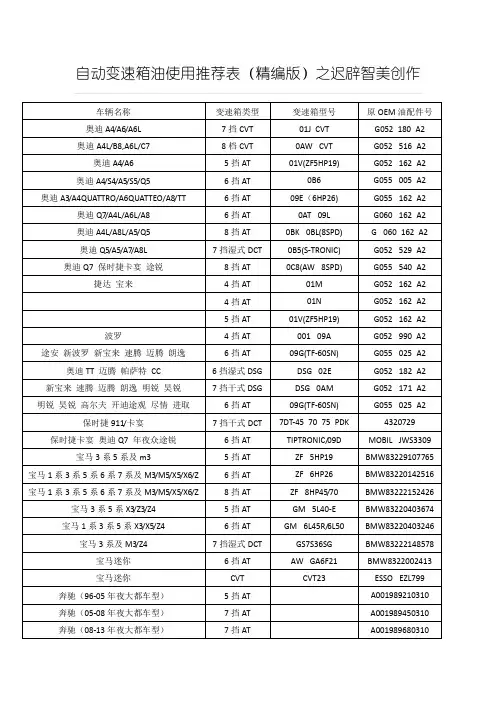
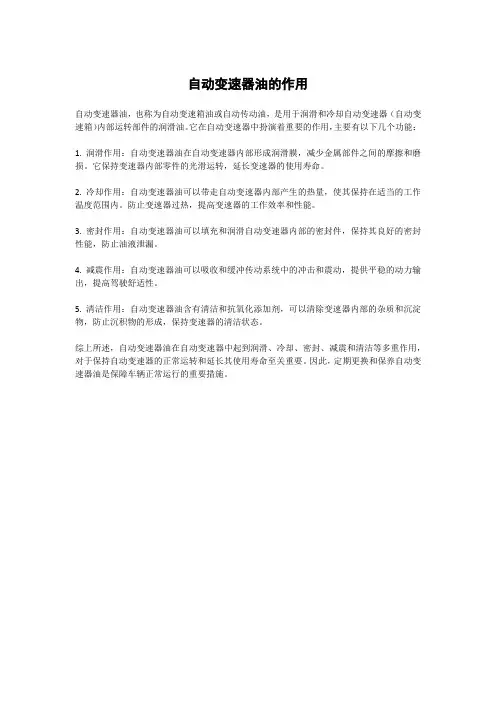
自动变速器油的作用
自动变速器油,也称为自动变速箱油或自动传动油,是用于润滑和冷却自动变速器(自动变速箱)内部运转部件的润滑油。
它在自动变速器中扮演着重要的作用,主要有以下几个功能:
1. 润滑作用:自动变速器油在自动变速器内部形成润滑膜,减少金属部件之间的摩擦和磨损。
它保持变速器内部零件的光滑运转,延长变速器的使用寿命。
2. 冷却作用:自动变速器油可以带走自动变速器内部产生的热量,使其保持在适当的工作温度范围内。
防止变速器过热,提高变速器的工作效率和性能。
3. 密封作用:自动变速器油可以填充和润滑自动变速器内部的密封件,保持其良好的密封性能,防止油液泄漏。
4. 减震作用:自动变速器油可以吸收和缓冲传动系统中的冲击和震动,提供平稳的动力输出,提高驾驶舒适性。
5. 清洁作用:自动变速器油含有清洁和抗氧化添加剂,可以清除变速器内部的杂质和沉淀物,防止沉积物的形成,保持变速器的清洁状态。
综上所述,自动变速器油在自动变速器中起到润滑、冷却、密封、减震和清洁等多重作用,对于保持自动变速器的正常运转和延长其使用寿命至关重要。
因此,定期更换和保养自动变速器油是保障车辆正常运行的重要措施。
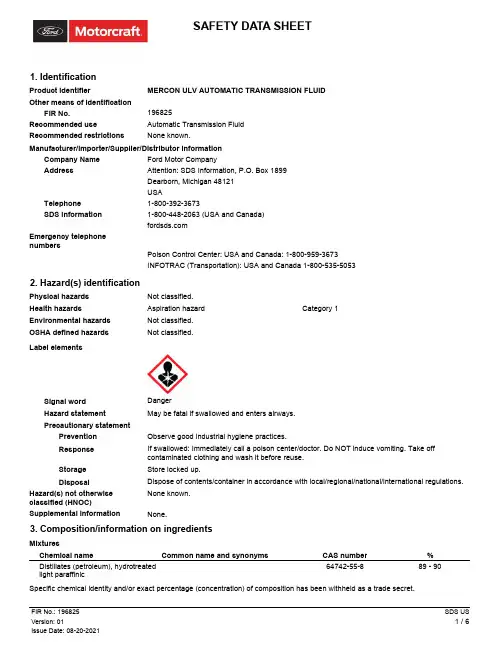
SAFETY DATA SHEET1. IdentificationMERCON ULV AUTOMATIC TRANSMISSION FLUIDProduct identifierOther means of identification196825FIR No.Automatic Transmission FluidRecommended useNone known.Recommended restrictionsManufacturer/Importer/Supplier/Distributor informationFord Motor CompanyCompany NameAttention: SDS Information, P.O. Box 1899AddressDearborn, Michigan 48121USA1-800-392-3673Telephone1-800-448-2063 (USA and Canada)SDS InformationEmergency telephonenumbersPoison Control Center: USA and Canada: 1-800-959-3673INFOTRAC (Transportation): USA and Canada 1-800-535-50532. Hazard(s) identificationNot classified.Physical hazardsAspiration hazardCategory 1Health hazardsNot classified.Environmental hazardsNot classified.OSHA defined hazardsLabel elementsSignal word DangerHazard statement May be fatal if swallowed and enters airways.Precautionary statementPrevention Observe good industrial hygiene practices.Response If swallowed: Immediately call a poison center/doctor. Do NOT induce vomiting. Take offcontaminated clothing and wash it before reuse.Storage Store locked up.Disposal Dispose of contents/container in accordance with local/regional/national/international regulations. Hazard(s) not otherwiseNone known.classified (HNOC)Supplemental information None.3. Composition/information on ingredientsMixturesCAS number% Chemical name Common name and synonyms89 - 90Distillates (petroleum), hydrotreated64742-55-8light paraffinicSpecific chemical identity and/or exact percentage (concentration) of composition has been withheld as a trade secret.4. First-aid measuresMove to fresh air. Call a physician if symptoms develop or persist.Inhalation Wash off with soap and water. Get medical attention if irritation develops and persists.Skin contact Rinse with water. Get medical attention if irritation develops and persists.Eye contact Call a physician or poison control center immediately. Rinse mouth. Do not induce vomiting. If vomiting occurs, keep head low so that stomach content doesn't get into the lungs.IngestionAspiration may cause pulmonary edema and pneumonitis.Most importantsymptoms/effects, acute and delayedProvide general supportive measures and treat symptomatically. Keep victim under observation.Symptoms may be delayed.Indication of immediatemedical attention and special treatment needed Ensure that medical personnel are aware of the material(s) involved, and take precautions to protect themselves.General information5. Fire-fighting measuresWater fog. Foam. Dry chemical powder. Carbon dioxide (CO2).Suitable extinguishing media Do not use water jet as an extinguisher, as this will spread the fire.Unsuitable extinguishing mediaDuring fire, gases hazardous to health may be formed. Upon decomposition, this product emits carbon monoxide, carbon dioxide and/or low molecular weight hydrocarbons.Specific hazards arising from the chemicalSelf-contained breathing apparatus and full protective clothing must be worn in case of fire.Special protective equipment and precautions for firefighters Move containers from fire area if you can do so without risk.Fire fightingequipment/instructions Use standard firefighting procedures and consider the hazards of other involved materials.Specific methods No unusual fire or explosion hazards noted.General fire hazards6. Accidental release measuresAvoid contact with eyes, skin, and clothing. Avoid inhalation of vapors and spray mists. Ensure adequate ventilation. Keep people away from and upwind of spill/leak. Keep unnecessarypersonnel away. Local authorities should be advised if significant spillages cannot be contained.Wear appropriate protective equipment and clothing during clean-up. For personal protection, see section 8 of the SDS.Personal precautions,protective equipment and emergency proceduresThe product is immiscible with water and will spread on the water surface.Large Spills: Stop the flow of material, if this is without risk. Dike the spilled material, where this is possible. Absorb in vermiculite, dry sand or earth and place into containers. Following product recovery, flush area with water.Small Spills: Wipe up with absorbent material (e.g. cloth, fleece). Clean surface thoroughly to remove residual contamination.Never return spills to original containers for re-use. For waste disposal, see section 13 of the SDS.Methods and materials for containment and cleaning upAvoid discharge into drains, water courses or onto the ground.Environmental precautions7. Handling and storageAvoid contact with eyes, skin, and clothing. Avoid breathing mist or vapor. Avoid prolongedexposure. Provide adequate ventilation. Observe good industrial hygiene practices. Wash hands thoroughly after handling. Wear appropriate personal protective equipment. For personal protection, see Section 8 of the SDS.Precautions for safe handlingStore locked up. Store in tightly closed container. Store away from incompatible materials (see Section 10 of the SDS).Conditions for safe storage,including any incompatibilities8. Exposure controls/personal protectionOccupational exposure limitsThe following constituents are the only constituents of the product which have a PEL, TLV or other recommended exposure limit.At this time, the other constituents have no known exposure limits.US. OSHA Table Z-1 Limits for Air Contaminants (29 CFR 1910.1000)Form Value Components Type PEL5 mg/m3Mist.Distillates (petroleum),hydrotreated light paraffinic (CAS 64742-55-8)US. ACGIH Threshold Limit Values FormValue ComponentsType TWA5 mg/m3Inhalable fraction.Distillates (petroleum),hydrotreated light paraffinic (CAS 64742-55-8)US. NIOSH: Pocket Guide to Chemical Hazards Form Value Components Type STEL10 mg/m3Mist.Distillates (petroleum),hydrotreated light paraffinic (CAS 64742-55-8)TWA 5 mg/m3Mist.No biological exposure limits noted for the ingredient(s).Biological limit values Use adequate ventilation to control airborne concentrations below the exposure limits/guidelines. If user operations generate a vapor, dust and/or mist, use process enclosure, appropriate local exhaust ventilation, or other engineering controls to control airborne levels below the recommended exposure limits/guidelines.Appropriate engineering controlsIndividual protection measures, such as personal protective equipmentWear safety glasses with side shields (or goggles).Eye/face protectionSkin protectionSuitable chemical protective gloves should be worn when the potential exists for skin exposure.The choice of an appropriate glove does not only depend on its material but also on other quality features and is different from one producer to the other. Nitrile gloves are recommended.Hand protectionWear appropriate chemical resistant clothing if applicable.OtherIf engineering controls do not maintain airborne concentrations to a level which is adequate to protect worker health, an approved respirator must be worn. Respirator selection, use and maintenance should be in accordance with the requirements of OSHA Respiratory Protection Standard 29 CFR 1910.134 and/or Canadian Standard CSA Z94.4.Respiratory protectionWear appropriate thermal protective clothing, when necessary.Thermal hazards Always observe good personal hygiene measures, such as washing after handling the material and before eating, drinking, and/or smoking. Routinely wash work clothing and protective equipment to remove contaminants.General hygiene considerations9. Physical and chemical propertiesAppearanceLiquid.Physical state Liquid.Form Red.Color PETROLEUM OdorOdor threshold Not available.pHNot available.Melting point/freezing point Not available.Initial boiling point and boiling range Not available.Flash point > 314.6 °F (> 157.0 °C) Pensky-Martens Closed Cup Evaporation rate Not available.Not applicable.Flammability (solid, gas)Upper/lower flammability or explosive limits Explosive limit - lower (%)Not available.Explosive limit - upper (%)Not available.Vapor pressure< 1 mm HgVapor density > 1 (Air=1)Relative density0.83 - 0.85 (Water=1)Relative density temperature 60.08 °F (15.6 °C)Solubility(ies)Solubility (water)Negligible Partition coefficient (n-octanol/water)Not available.Auto-ignition temperature Not available.Decomposition temperature Not available.Viscosity19 - 20 cSt Viscosity temperature104 °F (40 °C)10. Stability and reactivityThe product is stable and non-reactive under normal conditions of use, storage and transport.Reactivity Material is stable under normal conditions.Chemical stability No dangerous reaction known under conditions of normal use.Possibility of hazardous reactionsContact with incompatible materials.Conditions to avoid Strong oxidizing agents.Incompatible materials Upon decomposition, this product emits carbon monoxide, carbon dioxide and/or low molecular weight hydrocarbons.Hazardous decomposition products11. Toxicological informationInformation on likely routes of exposureInhalationBased on available data, the classification criteria are not met. Prolonged inhalation may be harmful.Skin contact Based on available data, the classification criteria are not met.Eye contact Based on available data, the classification criteria are not met.IngestionDroplets of the product aspirated into the lungs through ingestion or vomiting may cause a serious chemical pneumonia.Symptoms related to the physical, chemical andtoxicological characteristics Aspiration may cause pulmonary edema and pneumonitis.Information on toxicological effectsAcute toxicityMay be fatal if swallowed and enters airways.Prolonged skin contact may cause temporary irritation.Skin corrosion/irritation Direct contact with eyes may cause temporary irritation.Serious eye damage/eye irritationRespiratory or skin sensitizationRespiratory sensitizationNot a respiratory sensitizer.This product is not expected to cause skin sensitization.Skin sensitization No data available to indicate product or any components present at greater than 0.1% are mutagenic or genotoxic.Germ cell mutagenicity CarcinogenicityNot classifiable as to carcinogenicity to humans.IARC Monographs. Overall Evaluation of CarcinogenicityNot listed.OSHA Specifically Regulated Substances (29 CFR 1910.1001-1053)Not listed.This product is not expected to cause reproductive or developmental effects.Reproductive toxicitySpecific target organ toxicity -single exposureNot classified.Specific target organ toxicity -repeated exposureNot classified.Aspiration hazard May be fatal if swallowed and enters airways.Chronic effectsProlonged inhalation may be harmful.12. Ecological informationThe product is not classified as environmentally hazardous. However, this does not exclude the possibility that large or frequent spills can have a harmful or damaging effect on the environment.EcotoxicityNo data is available on the degradability of any ingredients in the mixture. Persistence and degradabilityBioaccumulative potential No data available.Mobility in soil Other adverse effectsNo other adverse environmental effects (e.g. ozone depletion, photochemical ozone creationpotential, endocrine disruption, global warming potential) are expected from this component.13. Disposal considerationsCollect and reclaim or dispose in sealed containers at licensed waste disposal site. Dispose of contents/container in accordance with local/regional/national/international regulations. Don't pollute. Conserve resources. Return used oil to collection centers.Disposal instructionsDispose in accordance with all applicable regulations.Local disposal regulations The waste code should be assigned in discussion between the user, the producer and the waste disposal company.Hazardous waste code Dispose of in accordance with local regulations. Empty containers or liners may retain some product residues. This material and its container must be disposed of in a safe manner (see:Disposal instructions).Waste from residues / unused productsSince emptied containers may retain product residue, follow label warnings even after container is emptied. Empty containers should be taken to an approved waste handling site for recycling or disposal.Contaminated packaging14. Transport informationDOTNot regulated as dangerous goods.IATANot regulated as dangerous goods.IMDGNot regulated as dangerous goods.Not established.Transport in bulk according toAnnex II of MARPOL 73/78 and the IBC Code15. Regulatory informationThis product is a "Hazardous Chemical" as defined by the OSHA Hazard Communication Standard, 29 CFR 1910.1200.US federal regulationsToxic Substances Control Act (TSCA)TSCA Section 12(b) Export Notification (40 CFR 707, Subpt. D)Not regulated.CERCLA Hazardous Substance List (40 CFR 302.4)Not listed.SARA 304 Emergency release notificationNot regulated.OSHA Specifically Regulated Substances (29 CFR 1910.1001-1053)Not listed.SARA 302 Extremely hazardous substanceSuperfund Amendments and Reauthorization Act of 1986 (SARA)Not listed.YesSARA 311/312 Hazardous chemicalAspiration hazardClassified hazard categoriesSARA 313 (TRI reporting)Not regulated.Other federal regulationsClean Air Act (CAA) Section 112 Hazardous Air Pollutants (HAPs) ListNot regulated.Clean Air Act (CAA) Section 112(r) Accidental Release Prevention (40 CFR 68.130)Not regulated.Not regulated.Safe Drinking Water Act(SDWA)International InventoriesAll components are listed or are exempt from listing on the Toxic Substances Control Act Inventory.16. Other information, including date of preparation or last revision08-20-2021Issue date Version 01Health: 0Flammability: 1Physical hazard: 0HMIS® ratingsHealth: 0Flammability: 1Instability: 0NFPA ratingsThis document was prepared by FCSD-Toxicology, Ford Motor Company, Diagnostic Service Center II, 1800 Fairlane Drive, Allen Park, MI 48101, USA, based in part on information provided by the manufacturer. The information on this data sheet represents our current data and is accurate to the best of our knowledge as to the proper handling of this product under normal conditions and in accordance with the application specified on the packaging and/or technical guidance literature. Any other use of the product which involves using the product in combination with any other product or any other process is the responsibility of the user. To the extent that there are any differences between this product’s Safety Data Sheet (SDS) and the consumer packaged product labels, the SDS should be followed.Preparation Information and DisclaimerXT-12-QULV, XT-12-QULV1Part number(s)。
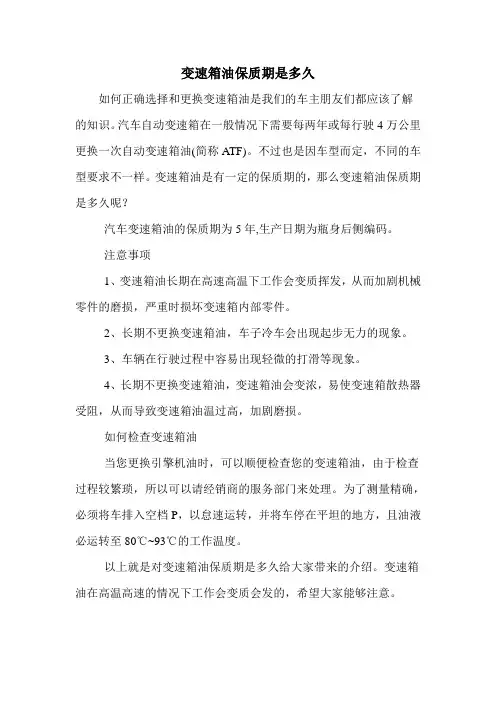
变速箱油保质期是多久
如何正确选择和更换变速箱油是我们的车主朋友们都应该了解的知识。
汽车自动变速箱在一般情况下需要每两年或每行驶4万公里更换一次自动变速箱油(简称ATF)。
不过也是因车型而定,不同的车型要求不一样。
变速箱油是有一定的保质期的,那么变速箱油保质期是多久呢?
汽车变速箱油的保质期为5年,生产日期为瓶身后侧编码。
注意事项
1、变速箱油长期在高速高温下工作会变质挥发,从而加剧机械零件的磨损,严重时损坏变速箱内部零件。
2、长期不更换变速箱油,车子冷车会出现起步无力的现象。
3、车辆在行驶过程中容易出现轻微的打滑等现象。
4、长期不更换变速箱油,变速箱油会变浓,易使变速箱散热器受阻,从而导致变速箱油温过高,加剧磨损。
如何检查变速箱油
当您更换引擎机油时,可以顺便检查您的变速箱油,由于检查过程较繁琐,所以可以请经销商的服务部门来处理。
为了测量精确,必须将车排入空档P,以怠速运转,并将车停在平坦的地方,且油液必运转至80℃~93℃的工作温度。
以上就是对变速箱油保质期是多久给大家带来的介绍。
变速箱油在高温高速的情况下工作会变质会发的,希望大家能够注意。
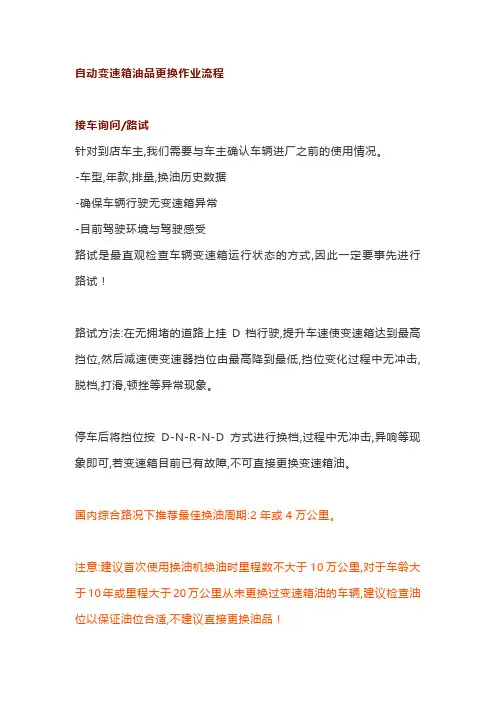
自动变速箱油品更换作业流程接车询问/路试针对到店车主,我们需要与车主确认车辆进厂之前的使用情况。
-车型,年款,排量,换油历史数据-确保车辆行驶无变速箱异常-目前驾驶环境与驾驶感受路试是最直观检查车辆变速箱运行状态的方式,因此一定要事先进行路试!路试方法:在无拥堵的道路上挂D档行驶,提升车速使变速箱达到最高挡位,然后减速使变速器挡位由最高降到最低,挡位变化过程中无冲击,脱档,打滑,顿挫等异常现象。
停车后将挡位按D-N-R-N-D 方式进行换档,过程中无冲击,异响等现象即可,若变速箱目前已有故障,不可直接更换变速箱油。
国内综合路况下推荐最佳换油周期:2年或4万公里。
注意:建议首次使用换油机换油时里程数不大于10万公里,对于车龄大于10年或里程大于20万公里从未更换过变速箱油的车辆,建议检查油位以保证油位合适,不建议直接更换油品!自动变速箱油品更换步骤放出旧油及油底壳拆卸发动机处于未工作状态,举升车辆到适合高度,卸下护板,打开变速箱放油螺丝,放出旧油(旧油可用量杯接上),旧油不再流出后安装回放油螺丝,将油底壳以及滤清器拆下。
清理变速箱底部接合面,确保无异物或损伤,如油底壳油泥,杂质较多,建议更换新油底壳,新滤清器以及新的油底壳衬垫,并在变速箱底部接合面上打一圈密封胶防止漏油,并注意油底壳螺丝安装扭矩。
备注:对于无法拆卸油底壳的变速箱可略过此步骤。
目前不少设备厂商及油品供应商宣传免拆洗的换油方式,但从专业的角度建议先行拆洗油底壳,根据情况适时更换油底壳及滤清器。
主要原因是:变速箱在长时间运行的过程中必然会产生油泥或其他金属细屑,而直接采用免拆洗的方式进行更换,会使变速箱油底壳上的油泥及金属细屑随着油压被滤清器阻挡。
造成滤清器表面附着物过多,而滤清器容尘量是有限度的,如果表面附着物过多必然会造成滤清器的传递效率降低,从而可能造成油液因压力不足导致变速箱故障。
同时,直接进行免拆洗更换,需要用更多的新油混入旧油,以达到将旧油循环出来的目的,造成油品的大量浪费,正常情况下,为达到相同效果比拆洗油底壳的方式油品使用量高出30%左右。
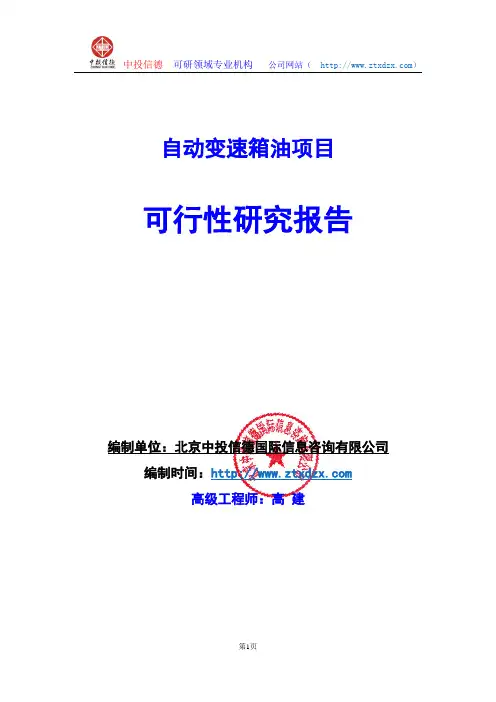
自动变速箱油项目可行性研究报告编制单位:北京中投信德国际信息咨询有限公司编制时间:高级工程师:高建关于编制自动变速箱油项目可行性研究报告编制说明(模版型)【立项 批地 融资 招商】核心提示:1、本报告为模板形式,客户下载后,可根据报告内容说明,自行修改,补充上自己项目的数据内容,即可完成属于自己,高水准的一份可研报告,从此写报告不在求人。
2、客户可联系我公司,协助编写完成可研报告,可行性研究报告大纲(具体可跟据客户要求进行调整)编制单位:北京中投信德国际信息咨询有限公司专业撰写节能评估报告资金申请报告项目建议书商业计划书可行性研究报告目录第一章总论 (1)1.1项目概要 (1)1.1.1项目名称 (1)1.1.2项目建设单位 (1)1.1.3项目建设性质 (1)1.1.4项目建设地点 (1)1.1.5项目主管部门 (1)1.1.6项目投资规模 (2)1.1.7项目建设规模 (2)1.1.8项目资金来源 (3)1.1.9项目建设期限 (3)1.2项目建设单位介绍 (3)1.3编制依据 (3)1.4编制原则 (4)1.5研究范围 (5)1.6主要经济技术指标 (5)1.7综合评价 (6)第二章项目背景及必要性可行性分析 (7)2.1项目提出背景 (7)2.2本次建设项目发起缘由 (7)2.3项目建设必要性分析 (7)2.3.1促进我国自动变速箱油产业快速发展的需要 (8)2.3.2加快当地高新技术产业发展的重要举措 (8)2.3.3满足我国的工业发展需求的需要 (8)2.3.4符合现行产业政策及清洁生产要求 (8)2.3.5提升企业竞争力水平,有助于企业长远战略发展的需要 (9)2.3.6增加就业带动相关产业链发展的需要 (9)2.3.7促进项目建设地经济发展进程的的需要 (10)2.4项目可行性分析 (10)2.4.1政策可行性 (10)2.4.2市场可行性 (10)2.4.3技术可行性 (11)2.4.4管理可行性 (11)2.4.5财务可行性 (11)2.5自动变速箱油项目发展概况 (12)2.5.1已进行的调查研究项目及其成果 (12)2.5.2试验试制工作情况 (12)2.5.3厂址初勘和初步测量工作情况 (13)2.5.4自动变速箱油项目建议书的编制、提出及审批过程 (13)2.6分析结论 (13)第三章行业市场分析 (15)3.1市场调查 (15)3.1.1拟建项目产出物用途调查 (15)3.1.2产品现有生产能力调查 (15)3.1.3产品产量及销售量调查 (16)3.1.4替代产品调查 (16)3.1.5产品价格调查 (16)3.1.6国外市场调查 (17)3.2市场预测 (17)3.2.1国内市场需求预测 (17)3.2.2产品出口或进口替代分析 (18)3.2.3价格预测 (18)3.3市场推销战略 (18)3.3.1推销方式 (19)3.3.2推销措施 (19)3.3.3促销价格制度 (19)3.3.4产品销售费用预测 (20)3.4产品方案和建设规模 (20)3.4.1产品方案 (20)3.4.2建设规模 (20)3.5产品销售收入预测 (21)3.6市场分析结论 (21)第四章项目建设条件 (22)4.1地理位置选择 (22)4.2区域投资环境 (23)4.2.1区域地理位置 (23)4.2.2区域概况 (23)4.2.3区域地理气候条件 (24)4.2.4区域交通运输条件 (24)4.2.5区域资源概况 (24)4.2.6区域经济建设 (25)4.3项目所在工业园区概况 (25)4.3.1基础设施建设 (25)4.3.2产业发展概况 (26)4.3.3园区发展方向 (27)4.4区域投资环境小结 (28)第五章总体建设方案 (29)5.1总图布置原则 (29)5.2土建方案 (29)5.2.1总体规划方案 (29)5.2.2土建工程方案 (30)5.3主要建设内容 (31)5.4工程管线布置方案 (32)5.4.1给排水 (32)5.4.2供电 (33)5.5道路设计 (35)5.6总图运输方案 (36)5.7土地利用情况 (36)5.7.1项目用地规划选址 (36)5.7.2用地规模及用地类型 (36)第六章产品方案 (38)6.1产品方案 (38)6.2产品性能优势 (38)6.3产品执行标准 (38)6.4产品生产规模确定 (38)6.5产品工艺流程 (39)6.5.1产品工艺方案选择 (39)6.5.2产品工艺流程 (39)6.6主要生产车间布置方案 (39)6.7总平面布置和运输 (40)6.7.1总平面布置原则 (40)6.7.2厂内外运输方案 (40)6.8仓储方案 (40)第七章原料供应及设备选型 (41)7.1主要原材料供应 (41)7.2主要设备选型 (41)7.2.1设备选型原则 (42)7.2.2主要设备明细 (43)第八章节约能源方案 (44)8.1本项目遵循的合理用能标准及节能设计规范 (44)8.2建设项目能源消耗种类和数量分析 (44)8.2.1能源消耗种类 (44)8.2.2能源消耗数量分析 (44)8.3项目所在地能源供应状况分析 (45)8.4主要能耗指标及分析 (45)8.4.1项目能耗分析 (45)8.4.2国家能耗指标 (46)8.5节能措施和节能效果分析 (46)8.5.1工业节能 (46)8.5.2电能计量及节能措施 (47)8.5.3节水措施 (47)8.5.4建筑节能 (48)8.5.5企业节能管理 (49)8.6结论 (49)第九章环境保护与消防措施 (50)9.1设计依据及原则 (50)9.1.1环境保护设计依据 (50)9.1.2设计原则 (50)9.2建设地环境条件 (51)9.3 项目建设和生产对环境的影响 (51)9.3.1 项目建设对环境的影响 (51)9.3.2 项目生产过程产生的污染物 (52)9.4 环境保护措施方案 (53)9.4.1 项目建设期环保措施 (53)9.4.2 项目运营期环保措施 (54)9.4.3环境管理与监测机构 (56)9.5绿化方案 (56)9.6消防措施 (56)9.6.1设计依据 (56)9.6.2防范措施 (57)9.6.3消防管理 (58)9.6.4消防设施及措施 (59)9.6.5消防措施的预期效果 (59)第十章劳动安全卫生 (60)10.1 编制依据 (60)10.2概况 (60)10.3 劳动安全 (60)10.3.1工程消防 (60)10.3.2防火防爆设计 (61)10.3.3电气安全与接地 (61)10.3.4设备防雷及接零保护 (61)10.3.5抗震设防措施 (62)10.4劳动卫生 (62)10.4.1工业卫生设施 (62)10.4.2防暑降温及冬季采暖 (63)10.4.3个人卫生 (63)10.4.4照明 (63)10.4.5噪声 (63)10.4.6防烫伤 (63)10.4.7个人防护 (64)10.4.8安全教育 (64)第十一章企业组织机构与劳动定员 (65)11.1组织机构 (65)11.2激励和约束机制 (65)11.3人力资源管理 (66)11.4劳动定员 (66)11.5福利待遇 (67)第十二章项目实施规划 (68)12.1建设工期的规划 (68)12.2 建设工期 (68)12.3实施进度安排 (68)第十三章投资估算与资金筹措 (69)13.1投资估算依据 (69)13.2建设投资估算 (69)13.3流动资金估算 (70)13.4资金筹措 (70)13.5项目投资总额 (70)13.6资金使用和管理 (73)第十四章财务及经济评价 (74)14.1总成本费用估算 (74)14.1.1基本数据的确立 (74)14.1.2产品成本 (75)14.1.3平均产品利润与销售税金 (76)14.2财务评价 (76)14.2.1项目投资回收期 (76)14.2.2项目投资利润率 (77)14.2.3不确定性分析 (77)14.3综合效益评价结论 (80)第十五章风险分析及规避 (82)15.1项目风险因素 (82)15.1.1不可抗力因素风险 (82)15.1.2技术风险 (82)15.1.3市场风险 (82)15.1.4资金管理风险 (83)15.2风险规避对策 (83)15.2.1不可抗力因素风险规避对策 (83)15.2.2技术风险规避对策 (83)15.2.3市场风险规避对策 (83)15.2.4资金管理风险规避对策 (84)第十六章招标方案 (85)16.1招标管理 (85)16.2招标依据 (85)16.3招标范围 (85)16.4招标方式 (86)16.5招标程序 (86)16.6评标程序 (87)16.7发放中标通知书 (87)16.8招投标书面情况报告备案 (87)16.9合同备案 (87)第十七章结论与建议 (89)17.1结论 (89)17.2建议 (89)附表 (90)附表1 销售收入预测表 (90)附表2 总成本表 (91)附表3 外购原材料表 (93)附表4 外购燃料及动力费表 (94)附表5 工资及福利表 (96)附表6 利润与利润分配表 (97)附表7 固定资产折旧费用表 (98)附表8 无形资产及递延资产摊销表 (99)附表9 流动资金估算表 (100)附表10 资产负债表 (102)附表11 资本金现金流量表 (103)附表12 财务计划现金流量表 (105)附表13 项目投资现金量表 (107)附表14 借款偿还计划表 (109) (113)第一章总论总论作为可行性研究报告的首章,要综合叙述研究报告中各章节的主要问题和研究结论,并对项目的可行与否提出最终建议,为可行性研究的审批提供方便。
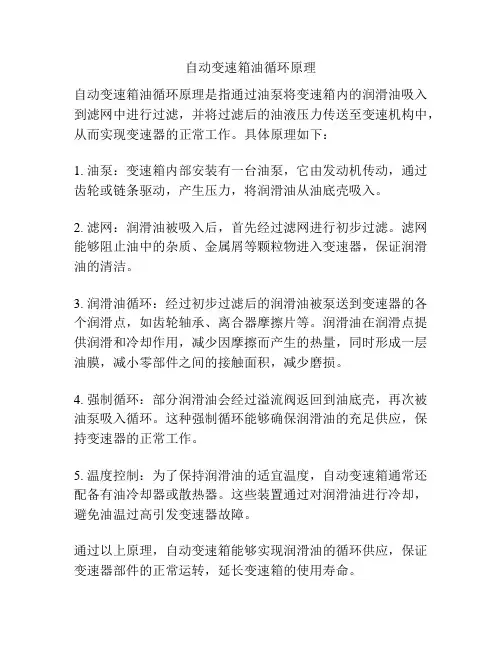
自动变速箱油循环原理
自动变速箱油循环原理是指通过油泵将变速箱内的润滑油吸入到滤网中进行过滤,并将过滤后的油液压力传送至变速机构中,从而实现变速器的正常工作。
具体原理如下:
1. 油泵:变速箱内部安装有一台油泵,它由发动机传动,通过齿轮或链条驱动,产生压力,将润滑油从油底壳吸入。
2. 滤网:润滑油被吸入后,首先经过滤网进行初步过滤。
滤网能够阻止油中的杂质、金属屑等颗粒物进入变速器,保证润滑油的清洁。
3. 润滑油循环:经过初步过滤后的润滑油被泵送到变速器的各个润滑点,如齿轮轴承、离合器摩擦片等。
润滑油在润滑点提供润滑和冷却作用,减少因摩擦而产生的热量,同时形成一层油膜,减小零部件之间的接触面积,减少磨损。
4. 强制循环:部分润滑油会经过溢流阀返回到油底壳,再次被油泵吸入循环。
这种强制循环能够确保润滑油的充足供应,保持变速器的正常工作。
5. 温度控制:为了保持润滑油的适宜温度,自动变速箱通常还配备有油冷却器或散热器。
这些装置通过对润滑油进行冷却,避免油温过高引发变速器故障。
通过以上原理,自动变速箱能够实现润滑油的循环供应,保证变速器部件的正常运转,延长变速箱的使用寿命。
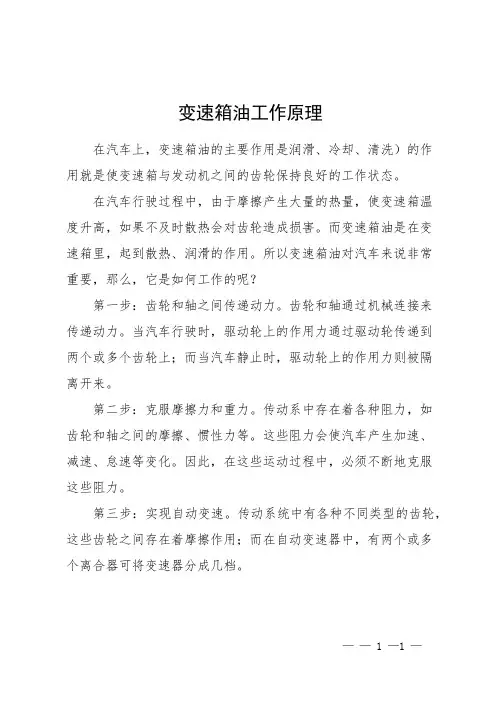
变速箱油工作原理
在汽车上,变速箱油的主要作用是润滑、冷却、清洗)的作
用就是使变速箱与发动机之间的齿轮保持良好的工作状态。
在汽车行驶过程中,由于摩擦产生大量的热量,使变速箱温
度升高,如果不及时散热会对齿轮造成损害。
而变速箱油是在变
速箱里,起到散热、润滑的作用。
所以变速箱油对汽车来说非常
重要,那么,它是如何工作的呢?
第一步:齿轮和轴之间传递动力。
齿轮和轴通过机械连接来
传递动力。
当汽车行驶时,驱动轮上的作用力通过驱动轮传递到
两个或多个齿轮上;而当汽车静止时,驱动轮上的作用力则被隔
离开来。
第二步:克服摩擦力和重力。
传动系中存在着各种阻力,如
齿轮和轴之间的摩擦、惯性力等。
这些阻力会使汽车产生加速、
减速、怠速等变化。
因此,在这些运动过程中,必须不断地克服
这些阻力。
第三步:实现自动变速。
传动系统中有各种不同类型的齿轮,这些齿轮之间存在着摩擦作用;而在自动变速器中,有两个或多
个离合器可将变速器分成几档。
—— 1 —1 —。

变速箱油更换标准
变速箱油更换的标准可以根据不同的车辆和制造商而有所不同。
以下是一般情况下的建议标准:
1. 里程标准:一般建议在行驶10,000到60,000英里(16,000到96,000公里)之间更换变速箱油。
请查阅您的车辆的用户手册或咨询制造商以获得具体的更换里程标准。
2. 时间标准:即使您的车辆里程数较低,也建议在一定时间间隔内更换变速箱油。
一般来说,每隔2到3年更换一次变速箱油是一个常见的建议。
3. 强制标准:在某些情况下,可能需要提前更换变速箱油。
例如,如果您经常进行拖车、重载或在恶劣的驾驶条件下行驶,这些情况可能会导致变速箱油更快地老化和磨损,因此需要更频繁地更换变速箱油。
请注意,这些标准只是一般建议,具体的更换标准可能因车辆制造商的要求、车辆使用条件和个人偏好而有所不同。
因此,最好参考您的车辆用户手册或咨询专业的汽车技师以获得准确的建议。
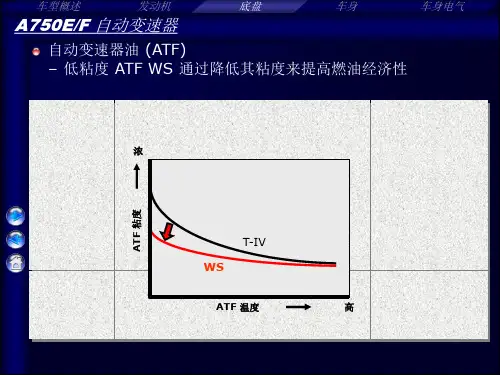
更换变速器油教学设计一、教学目标1.理解变速器工作原理;2.学会更换变速器油的步骤和方法;3.掌握变速器油更换的注意事项。
二、教学内容1.变速器油的作用和重要性;2.变速器油的更换步骤;3.变速器油更换的注意事项。
三、教学过程1.引入新知识(10分钟)引导学生回顾汽车的传动系统,提问:“你知道汽车的变速器有什么作用吗?”引导学生思考变速器的作用,并鼓励他们回答问题。
解释变速器的作用:变速器是汽车传动系统中非常重要的一个组成部分,它负责将发动机产生的动力传递到车轮上,以控制车辆的运动和速度。
引入变速器油的概念:为了使变速器正常运转,变速器内部需要润滑油润滑和冷却,这就是变速器油的作用。
2.变速器油的更换步骤(30分钟)-步骤一:准备工具和材料-扳手、油盘、新的变速器油和油尺。
-步骤二:将车辆抬高-使用千斤顶将车辆抬高,以便于更换变速器油。
-步骤三:找到变速器油排放螺丝-根据车辆的具体型号和变速器类型,找到变速器油排放螺丝。
这个位置可能会因车型而异,一般位于变速器底部。
-步骤四:准备油盘-将油盘放置在变速器底部,以接收旧变速器油的排放。
-步骤五:打开变速器油排放螺丝-使用扳手打开变速器油排放螺丝,排放旧变速器油。
-步骤六:放好变速器油排放螺丝-确保旧变速器油完全排放完成后,将变速器油排放螺丝放好。
-步骤七:倒入新的变速器油-使用漏斗将新变速器油倒入变速器油孔中,直到变速器内的油液达到油尺标记线。
-步骤八:检查变速器油液-使用油尺检查变速器油液的量,确保处于正常范围内。
3.变速器油更换的注意事项(20分钟)-注意事项一:更换周期-变速器油的更换周期一般为2万至5万公里,或者根据汽车厂家的建议进行更换。
-注意事项二:使用正确的变速器油-不同车型的变速器可能使用不同种类的变速器油,要根据车辆的具体型号和厂家建议,选择适合的变速器油。
-注意事项三:避免变速器油受到污染-在更换变速器油之前,清洗周围的工作区域,避免杂质进入变速器内部。
八代本田雅阁重力换油法更换变速箱油图解变速箱放油螺栓位置
变速箱放油螺栓位置
准备好空的接废变速箱油的容器。
注意:
基本原则是,放出多少变速箱油,就补充多少变速箱油。
可以准备两个容器,等变速箱油,流出基本完毕,到滴油状态时,换上空的容器,静置一个晚上,看看能滴下多少油来。
重力换油法,不能完全放干净离合器内油和液力变矩器内的油液。
有的资料说是,换三次油。
既:更换新油后,跑两天,再第二次换油,再跑两天,再第三次换油。
通过三次换油循环,将油绝大部分更换掉。
实际上,我只是更换了一次,因为,经过一个晚上的滴油,除了液力变矩器内和离合器内的油液有少量剩余,其余的已经所剩无几。
到底离合器内和液力变矩器内油液剩余多少?根据我拆解变速箱的经验,已经所剩不多了。
手中拿的是,放油螺栓,上面沾满了黑色磁性铁粉,用卫生纸擦干净即可。
放出了大致4升变速箱油后,更换新的空容器,静置一个晚上看看能滴出多少油液。
滴油静置等待
尝试换挡后转动车轮,企图空出更多的油液,但是发现,换挡后,用手转动车轮,不能滴落大量油液。
干脆,让车在D挡上,随便他慢慢滴落吧。
不大赞成,启动发动机,挂挡,空转车辆的方法,放出更多油液。
这种方法,对油泵等伤害太大。
正规渠道买的变速箱油,确保原厂真货。
变速箱油安全技术说明书
变速箱油是汽车变速器传动系统中必不可少的重要组成部分之一,起着润滑、降温、减少摩擦和磨损等重要作用。
随着汽车行业的快速
发展,变速箱油的质量也越来越受到关注,一定要选择合适的变速箱油,才能保证汽车的安全与可靠性。
首先,选择适合自己车型的变速箱油非常重要。
不同的车型所需
要的变速箱油也有所区别,如果选用错误的变速箱油,将会影响汽车
的性能和安全。
因此,在购买变速箱油时一定要仔细查看车辆使用说
明书或者咨询专业的汽车维修保养人员,才能选择到最适合自己车型
的变速箱油。
其次,变速箱油的更换时间也非常关键。
变速箱油在长时间的使
用过程中,不仅会遭受高温剧烈摩擦的磨损,还会吸附异物、水分等
一系列污染物,影响油品质量。
因此,建议按照车辆的使用说明书要
求或者专业维修人员的建议定期更换变速箱油,以保证油品的清洁度
和稳定性。
最后,使用变速箱油时,一定要注意安全问题。
变速箱油属于易
燃易爆品,使用过程中要远离火源,避免发生意外。
此外,在更换变
速箱油时,需要采用专业的设备和工具,避免油品的泄露和污染。
更
换过程中要先切断电源,并将车辆牢固地固定在支架上,以保证操作
安全。
综上所述,选择合适的变速箱油、定期更换变速箱油、注意油品的安全问题,才能保证汽车的安全可靠,延长其使用寿命。
希望广大车主朋友在日常使用中,注重变速箱油的保养和维护,让我们的爱车拥有更长久的美好时光。
循环机换变速箱油教程_GF6(6AT)自动变速箱油什么时
间换最合适看完知道了
GF6(6AT)自动变速箱油的换油时间可以根据以下几个因素来决定:
车辆使用时间、车辆行驶里程、变速箱工作环境和变速箱使用条件等。
一
般建议车主在车辆行驶10万公里左右进行首次换油,之后每隔3-5万公
里进行一次变速箱油的更换。
下面将详细介绍GF6(6AT)自动变速箱油的更换步骤:
步骤1:提升车辆
首先,将车辆提升至制造商规定的高度,以便更好地访问变速箱下部。
步骤2:寻找排放螺栓
在变速箱的侧面或底部,可以找到一个排放螺栓。
使用工具打开这个
螺栓,用容器接住旧的变速箱油。
步骤3:更换滤芯
寻找变速箱内的滤芯,通常位于侧面。
使用相应工具拆卸滤芯,并将
其替换为新的滤芯。
步骤4:添加新油
找到变速箱上的加注口,使用漏斗将新的变速箱油缓慢加入。
加注时
应保持车辆在水平状态下。
步骤5:检查油位
加注完成后,使用变速箱油尺检查油位。
确保油位在合适的范围内。
步骤6:启动车辆
启动车辆,并让引擎运行几分钟,以使新变速箱油充分循环。
步骤7:检查油位再次
熄火后,再次使用变速箱油尺检查油位。
确保油位仍然在合适的范围内。